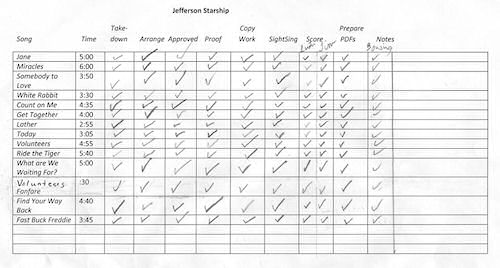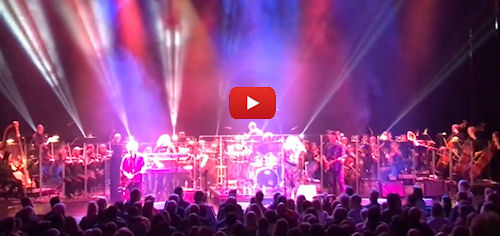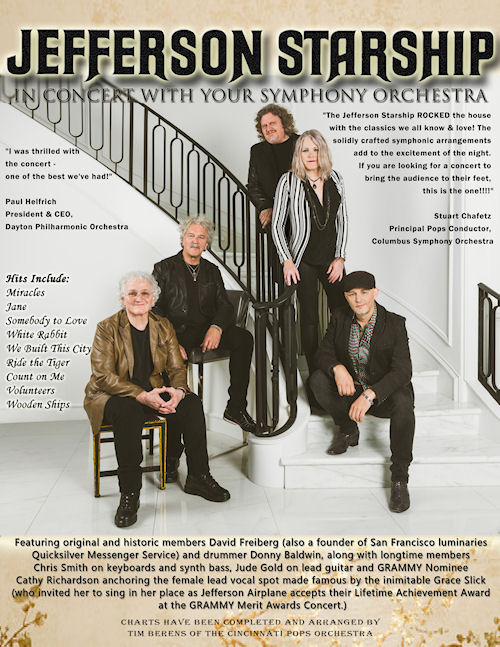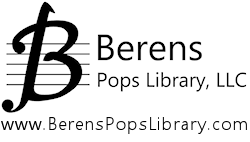
|
Case Study: Jefferson Starship |

Pops Library
Bio
Guitarist
Arranger
Conductor
Listen
Gallery
Fun Stuff
Contact
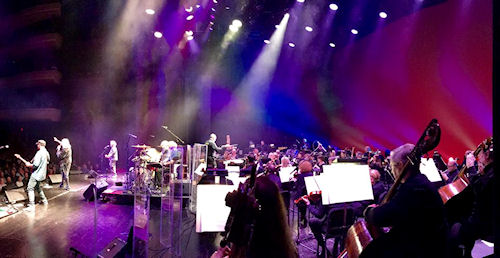
In 2017, we were contacted by Jefferson Starship's management team about writing an orchestra show for the band. We negotiated fees, then helped set up the premiere performance with the Dayton Philharmonic Orchestra. With the business end of the project firmly in place, we set about the artistic (fun!) part.
Louise and I visited with Cathy Richardson, the band's lead singer, in her home in Chicago. We talked about which songs from their vast repertoire (which includes all of Jefferson Airplane, Jefferson Starship, and Starship) would work best in an orchestral setting.
After the set list was created, Louise and I got busy.
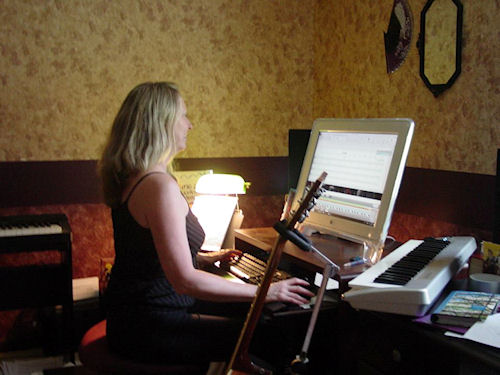 |
| Louise's workstation. |
The image below shows the checklist we use to help us navigate large projects like the show for Jefferson Starship.
Each row is a song. Each column is a task that must be completed for the song. The tasks must be done in the order indicated moving left to right. The checklist is essential because of the involvement of the members of the band for the Approved column. They tour frequently, so it would often take them many days to approve or request changes to the arrangements. We kept moving forward with other tasks while they travelled.
The columns are:
Song Name: The name of the song.
Time: The length of the song.
Takedown: Louise does the initial takedown of the song. She listens to a recent live recording of the band, and enters the melody, lyrics, chord changes and bass line into Sibelius in the form they currently use.
Arrange: Using Louise's takedown as a baseline, I arrange and orchestrate the music. Usually the form is dictated by what the band is accustomed to playing.
Approved: I created MIDI files that had nothing but the orchestra parts and emailed them to the 5 members of the band. They replied with suggestions/comments/criticisms. I made the changes, and emailed another MIDI file. Some songs went to 5 and 6 drafts. Others were good after one draft. The members of the band actively participated. The lead singer liked to call me up and say "After the second chorus, I want to hear the tuba and timpani playing . . . " and then she would sing to me what she wanted to hear. I wrote it down and entered it into Sibelius. It was a satisfying collaboration.
Proof: I do an elaborate proofing of the music. It takes several hours, but this is time well-spent. This is the first of 3 layers of proofing that our projects go through.
Copy work: Once I am satisfied with the orchestration, I turn the file over to Louise. She does the engraving work to make the parts look gorgeous, and does the second layer of proofing during this process.
Sight Sing: After Louise completes the engraving, I sightsing every note in every part. It takes several hours, but this step puts the finishing touches of perfection on the arrangements. These are one-rehearsal arrangements. There can be no mistakes in them. They will be performed in front of a live audience 6 hours after they are rehearsed for the first time. No room for error.
Score: After the parts are completely done, Louise creates the conductor's part, which is also called the Score. After she creates the score, I proof the score.
Prepare PDFs: For small projects, we print them ourselves. For large projects like this one, it is more economical, and much faster, to send them to a professional printer. For this step, I create PDFs of all the parts and scores along with instructions for how to print each part.
Bowing: In this step, I create PDF bowing masters that were sent to the Dayton Philharmonic Orchestra as soon as they were available so their string principals could bow the parts.
With a giant pile of parts and scores in front of us, Louise and I created the individual folders for the musicians and sent the show to the Dayton Philharmonic Orchestra's library.
The show was premiered on November 2, 2018 by the Dayton Philharmonic Orchestra, with one rehearsal on the day of the show. The charts were flawless. The orchestra's musicians loved playing them.
The audience's reaction to the show's premiere was wild. They gave the band and orchestra five standing ovations throughout the concert and remained on their feet for the final three songs.
Paul Helfrich, the DPO's President and CEO said "I was thrilled with the concert - one of the best we've had!" Neal Gittleman, the DPO's conductor, said in a Facebook post, "Backstage at the DPO with Jefferson Starship after a fabulous show to open the Rockin' Orchestra Series. Band sounded great, orchestra sounded great, audience went nuts. What more could you ask for?"
In Columbus, the crowd stood in the rain and cheered wildly, screaming for more at the end of the concert. In April, 2020, I will be conducting the Jefferson Starship orchestra show with the Buffalo Philharmonic Orchestra. Click here for details.
Jefferson Starship's management is currently booking this show throughout the country. For information, contact Jim Lenz.
© 2002 - 2020, Tim Berens
All rights reserved
